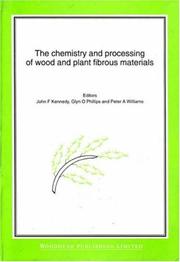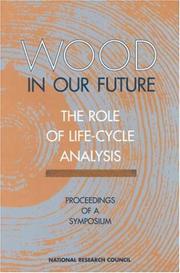| Listing 1 - 10 of 15 | << page >> |
Sort by
|
Book
ISBN: 9781620819869 1620819864 9781620819739 1620819732 Year: 2012 Publisher: New York : Nova Science Publishers,
Abstract | Keywords | Export | Availability | Bookmark
 Loading...
Loading...Choose an application
- Reference Manager
- EndNote
- RefWorks (Direct export to RefWorks)
Book
ISBN: 3036571612 3036571604 Year: 2023 Publisher: Basel : MDPI - Multidisciplinary Digital Publishing Institute,
Abstract | Keywords | Export | Availability | Bookmark
 Loading...
Loading...Choose an application
- Reference Manager
- EndNote
- RefWorks (Direct export to RefWorks)
Wood is a natural material that is available in large quantities and is easy to produce, making it the perfect material to consider for the circular economy. Its importance has dramatically increased in recent years. This increase is accompanied by the development of new research methods that open new possibilities in the areas related to wood and wood products in the process of their production, processing, and final use. The main topics of this Special Issue were the knowledge of the quality of wood and other lignocellulose materials; the processes of their effective utilization and processing for more efficient processing; the adoption of techniques and research around using wood for environmentally friendly composite production and the positive impact of this on the environment; wood's interaction with solid substances and with different mechanical loads, chemicals, and other substances; and the different forms of energy and surface modification of wood and wood composites.
Book
ISBN: 3036571868 3036571876 Year: 2023 Publisher: Basel : MDPI - Multidisciplinary Digital Publishing Institute,
Abstract | Keywords | Export | Availability | Bookmark
 Loading...
Loading...Choose an application
- Reference Manager
- EndNote
- RefWorks (Direct export to RefWorks)
Traditional wood composites are produced with synthetic, formaldehyde-based adhesives, commonly made from fossil-derived constituents, such as urea, phenol, melamine, etc. Along with their undisputable advantages, these adhesives are characterized by certain problems, connected with the emission of hazardous volatile organic compounds (VOCs), including free formaldehyde emission from the finished wood composites, which is carcinogenic to humans and harmful to the environment. The growing environmental concerns, connected with the adoption of circular economy principles, and the new, stricter legislative requirements for the emission of harmful VOCs, e.g., free formaldehyde, from wood composites, have posed new challenges to researchers and industrial practice, related to the development of sustainable, eco-friendly wood composites, optimization of the available lignocellulosic raw materials, and use of alternative resources.
Wood products. --- Furniture making. --- Furniture --- Furniture building --- Joinery --- Woodwork --- Timber products --- Forest products --- Building
Book
ISBN: 9282602516 9789282602515 Year: 1990 Publisher: Luxembourg: Office des publications officielles des Communautés européennes,
Abstract | Keywords | Export | Availability | Bookmark
 Loading...
Loading...Choose an application
- Reference Manager
- EndNote
- RefWorks (Direct export to RefWorks)
Distribution strategy --- Forestry --- Wood products --- Woodworking industries --- Woodworking machinery --- Terminology --- Terminology. --- -Wood products --- -Woodworking machinery --- -Machinery --- Timber products --- Forest products --- -Terminology --- -Timber products --- Machinery --- Woodworking industries - Terminology. --- Wood products - Terminology. --- Woodworking machinery - Terminology.
Periodical
Abstract | Keywords | Export | Availability | Bookmark
 Loading...
Loading...Choose an application
- Reference Manager
- EndNote
- RefWorks (Direct export to RefWorks)
Wood --- Wood products --- Wood industry. --- Timber products --- Forest products --- Materials processing --- Architecture --- Agriculture Sciences --- Agro Business, Economics and Policies

ISBN: 1855733056 184569869X 9781845698690 9781855733053 Year: 2010 Publisher: Cambridge, England : Woodhead Publishing Limited,
Abstract | Keywords | Export | Availability | Bookmark
 Loading...
Loading...Choose an application
- Reference Manager
- EndNote
- RefWorks (Direct export to RefWorks)
This book covers the production, management and changing patterns of global wood and fibre resources, with emphasis on the inter-disciplinary character of wood and related plant materials in terms of their resource value.
Wood products --- Plant fibers --- Forest products industry --- Plant fiber industry --- Plant products industry --- Plant textile fibers --- Textile fibers, Plant --- Vegetable fibers --- Fibers --- Plant products --- Fiber plants --- Timber products --- Forest products
Periodical
Abstract | Keywords | Export | Availability | Bookmark
 Loading...
Loading...Choose an application
- Reference Manager
- EndNote
- RefWorks (Direct export to RefWorks)
Wood products --- Forest products industry --- Woodwork --- Woodworking industries --- Forest products industry. --- Wood products. --- Woodwork. --- Woodworking industries. --- Wood craft --- Woodcraft --- Woodworking --- Decorative arts --- Machining --- Manufacturing processes --- Carpentry --- Fretwork --- Timber products --- Forest products --- Forest industries --- Forestry industry --- Wood products industry --- Wood-using industries --- Plant products industry --- Materials processing --- Architecture
Book
ISBN: 3030166880 3030166872 Year: 2019 Publisher: Cham : Springer International Publishing : Imprint: Springer,
Abstract | Keywords | Export | Availability | Bookmark
 Loading...
Loading...Choose an application
- Reference Manager
- EndNote
- RefWorks (Direct export to RefWorks)
This book is the first attempt to summarize the existing scientific methods and to present new developments and results in this field. First of all, a large array of functional relationships was elaborated and described in details in a voluminous chapter. Beside the strict mathematical optimization methods, an engineering approach is outlined and demonstrated in many worked examples. The essence of this approach is a recognition that, in many practical cases, the optimum is uniquely determined by a particular constraint. The scientific methods of engineering design of wood products are discussed, compared and illustrated with numerical examples. Special attention is paid to the joint elements and, for their easy optimum selection, new similarity equations are developed and illustrated by practical examples. In the last chapter, the general principles of optimum manufacture, interactions among product structure, degree of automation and optimized production technology are discussed. The main woodworking operations are also described and reference is given for optimum selection of their operational parameters. In the Appendix, over 50 colour pictures demonstrate the unique ornamental properties of various timber materials.
Wood products. --- Timber products --- Forest products --- Manufactures. --- Wood. --- Engineering. --- Manufacturing, Machines, Tools, Processes. --- Wood Science & Technology. --- Machinery and Machine Elements. --- Construction --- Industrial arts --- Technology --- Building materials --- Trees --- Timber --- Manufactured goods --- Manufactured products --- Products --- Products, Manufactured --- Commercial products --- Manufacturing industries --- Forest products. --- Machinery. --- Machinery --- Machines --- Manufactures --- Power (Mechanics) --- Mechanical engineering --- Motors --- Power transmission --- Forest production --- Botany, Economic --- Raw materials --- Curious devices

ISBN: 1281774642 9786611774646 1859574289 9781859574287 9781859573594 1859573592 9781281774644 Year: 2002 Publisher: Shawbury, U.K. : Rapra Technology Ltd.,
Abstract | Keywords | Export | Availability | Bookmark
 Loading...
Loading...Choose an application
- Reference Manager
- EndNote
- RefWorks (Direct export to RefWorks)
Natural fibres have been used to reinforce materials for over 3,000 years. More recently they have been employed in combination with plastics. One of the earliest examples (1950) was the East German Trabant car, the body was constructed from polyester reinforced with cotton fibres. Currently many types of natural fibre are being investigated for use in plastics including: flax, hemp, jute, straw, wood fibre, rice husks, wheat, barley, oats, rye, cane (sugar and bamboo), grass, reeds, kenaf, ramie, oil palm empty fruit bunch sisal, coir, water hyacinth, pennywort, kapok, paper-mulberry, raphia,
Composite materials. --- Plastics. --- Wood products. --- Timber products --- Forest products --- Plastic materials --- Plastic products --- Polymers --- Synthetic products --- Condensation products (Chemistry) --- Elastomers --- Plasticity --- Composites (Materials) --- Multiphase materials --- Reinforced solids --- Solids, Reinforced --- Two phase materials --- Materials --- Matières plastiques renforcées avec des fibres --- Composites polymères

ISBN: 0309057450 0309520932 0585156352 9780585156354 9780309057455 0309174791 Year: 1997 Publisher: Washington, D.C. : National Academy Press,
Abstract | Keywords | Export | Availability | Bookmark
 Loading...
Loading...Choose an application
- Reference Manager
- EndNote
- RefWorks (Direct export to RefWorks)
Forest products industry --- Life cycle costing --- Paper products --- Product life cycle --- Wood products --- Congresses. --- Environmental aspects --- Forest products industry -- Congresses. --- Life cycle costing -- Congresses. --- Paper products -- Congresses. --- Product life cycle -- Environmental aspects -- Congresses. --- Wood products -- Congresses. --- Costing, Life cycle --- L.C.C. (Life cycle costing) --- LCC (Life cycle costing) --- Life cycle cost --- Life cycle cost analysis --- Terotechnology --- Paper manufactures --- Timber products --- Costs, Industrial --- Manufactures --- Life cycle, Product --- Marketing --- Product management --- Forest products --- Life cycle --- Environmental Sciences and Forestry. Forestry -- Forest Products -- Wood and Wood Products --- ALLW.
| Listing 1 - 10 of 15 | << page >> |
Sort by
|

 Search
Search Feedback
Feedback About UniCat
About UniCat  Help
Help News
News